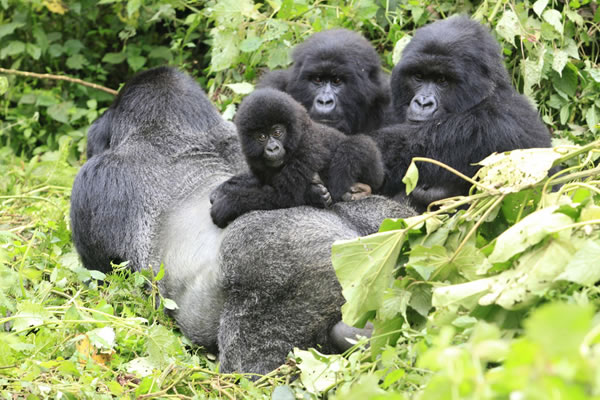Gorilla Trekking
Mgahinga Gorilla National Park is home to some of the world’s endangered mountain gorillas making gorilla trekking a must do activity while at the park.
The trek commences at about 8am and lasts 2 to 4 hours, which duration is mostly dependent on the location of the gorillas or how far they moved in their search for food.
There are a few guidelines to keep in mind before you go gorilla trekking which you will be acquainted with at the orientation but we picked a few to keep in mind before then.
Gorillas can catch human diseases so if you have a cold or other infectious diseases, it is wise that you save the adventure for after your recovery.
If you have to ease yourself while gorilla trekking, all waste must be buried 30cm deep. Flash photography should not be used and all trekkers should be at least 15 years of age.
Only 8 people per trekking group are allowed. Depending on how far the gorillas moved, your reward for the trek maybe a silver-back out of the 5 in the one family of Gorillas found in the park.
This ought to remind you that by trekking you have a chance to see the gorillas but it is not a guaranteed that you will see them.
Volcano Climbing:
The amazing thing about this park is that you can combine all kinds of activities here including the climbing of 3 majestic Virunga Volcanoes – and each of the volcanoes can be climbed in one day – one does not have the added expenses such as hiring porters, tents, bringing along food for the climb.
Mount Muhavura is the highest of them all with the advantage of seeing the other Virunga Mountains from its peak.
It can be seen from as far as Kisoro town and is justifiably called the guide given how it leads one to the rest of the mountains in the ranges.
Mount Sabinyo is a gateway to Rwanda and the DRC while in Uganda; at its peak you are geographically standing in Rwanda, Uganda and The DRC at the same time!
The way to the summit of Sabinyo is filled with mushy vegetation whose uncomfortable impact can be reduced by dressing appropriately in waterproof hiking boots.
Climbing up Mount Gahinga on the other hand requires a hike through a bamboo forest. All three of these mountains can be climbed in a day each up to their summits as long as you are in good physical shape.
The Batwa Trail encounter
For generations, Mgahinga’s dense forests were home to the indigenous Batwa – hunter-gatherers and fierce warriors who depended on the forest for shelter, food and medicine.
Now they lead visitors through the forests and introduce them to their old home – and the techniques they used to survive in it.
A Batwa trail experience is an activity that takes you through their history and transition over time. The Garama Cave, a very sacred piece of Batwa history is a good place to start.
It is in this cave that they were able to hide from Bantu invasion many years back. The ease with which they bustle through the forest and glide uphill is awe striking and a reminder that east or west, home is best to the Batwa.
Birding
Birding is one interesting activity to do in Mgahinga gorilla national park since over 115 species of interesting birds are habituated by the entire features of the forest that include lakes, the dormant volcanoes, caves and the entire bamboo forests.
Mgahinga gorilla national park offers one of the best birding in Uganda with its registered species of birds that exceed 115 hence taking most beautiful scenery in the gorge between Gahinga and Sabinyo, hike through the bamboo forest, and in the montane forest that habitats beautiful Rwenzori turaco, Mgahinga gorilla national park’s extinct volcanoes bare bamboo forests that habitat different species of birds and the lava tubes that create caves which also happen to habitat other kinds of bird species which offer an extra scenery to the tourists.
Uganda happens to be one blessed country that habitats different species of birds as they are occupying different bird sanctuaries and forests across the country plus seasonal birds that visit the showers of Lake Victoria.
Golden Monkey Tracking
Mgahinga National Park offers the chance to track the golden monkeys (Ceropithecus Kandti) sometimes referred to as a distinctive race of the more widespread blue monkey, a little known bamboo-associated taxa primate listed as ‘endangered’ by the World Conservation Union.
Endemic to the Albertine Rift, the golden monkey is characterized as a bright orange-gold body, cheeks and tail, contrasting with its black limbs, crown and tail end.
The family is very much used to our presence now, allowing us to have an insight into their daily lives. The monkeys dictate how the day is going to be, and no day is ever the same in the forest.
We just never know how the working day is going to turn out, and this is what makes the experience so exciting. You will encounter challenges regularly. One of our biggest problems is the weather.
Trekking at an altitude of around 2,500 meters you will encounter strong winds, heavy rainfall and extreme coldness, so is the best place to trek the golden monkey or gorillas though not reliable.


